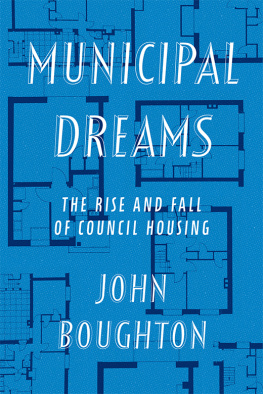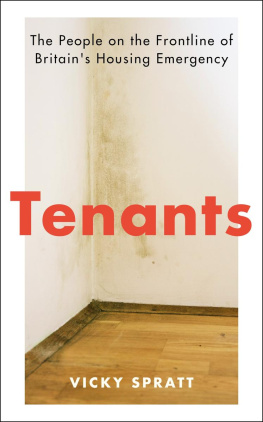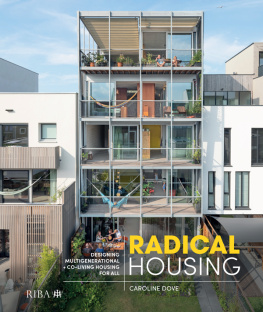Municipal Dreams
The Rise and Fall of Council Housing
John Boughton

First published by Verso 2018
John Boughton 2018
All rights reserved
The moral rights of the author have been asserted
1 3 5 7 9 10 8 6 4 2
Verso
UK: 6 Meard Street, London W1F 0EG
US: 20 Jay Street, Suite 1010, Brooklyn, NY 11201
versobooks.com
Verso is the imprint of New Left Books
ISBN-13: 978-1-78478-739-4
ISBN-13: 978-1-78478-741-7 (UK EBK)
ISBN-13: 978-1-78478-742-4 (US EBK)
British Library Cataloguing in Publication Data
A catalogue record for this book is available from the British Library
Library of Congress Cataloging-in-Publication Data
Names: Boughton, John (Historian), author.
Title: Municipal dreams : the rise and fall of council housing / John Boughton.
Description: London ; Brooklyn, NY : Verso, 2018. | Includes bibliographical references and index. |
Identifiers: LCCN 2017051179 (print) | LCCN 2017054562 (ebook) | ISBN 9781784787424 () | ISBN 9781784787394 (alk. paper)
Subjects: LCSH: Public housingGreat BritainHistory. | Low income housingGreat BritainHistory. | Working classHousingGreat BritainHistory. | Housing policyGreat BritainHistory.
Classification: LCC HD7288.78.G7 (ebook) | LCC HD7288.78.G7 B68 2018 (print) | DDC 363.50941dc23
LC record available at https://lccn.loc.gov/2017051179
Typeset in Fournier by Hewer Text UK Ltd, Edinburgh
Printed and bound by CPI Group (UK) Ltd, Croydon, CR0 4YY
Contents
As I write, the charred remains of Grenfell Tower loom over North Kensington. At times, as you walk around its base among the low-rise blocks of the leafy Lancaster West Estate to which it belonged, you can almost forget the events of 14 June 2017. But then youll see another of the ubiquitous posters of those missing in the fire, or raise your eyes and see the tower: a blackened twenty-four-storey hulk scene, now symbol, of one of Britains worst peacetime housing disasters and funeral pyre for numbers as yet untold.
The fire at Grenfell was, above all, a personal tragedy to its residents and their friends and families. But to many more it symbolised, in devastating fashion, a crisis in social housing. It stood as an awful culmination to deeply damaging policies pursued towards council housing, and the public sector more widely, since 1979.
The lessons of Grenfell will continue to unfold and will always be disputed but some clear conclusions seem inescapable. The fire appears to condemn a very common recent form of tower block renovation. At present, dangerously combustible cladding has been found in every sample taken from similarly refurbished blocks across the country. It seems to indict a model of social housing management, seen here as distant to residents interests and oblivious to the fire safety concerns they raised. It brings into question the system of commercially driven procurement and publicprivate partnership that has become near-ubiquitous in the social housing regeneration of recent years. And, more broadly, it challenges the cost-cutting, austerity agenda that has dominated public policy in the past forty years. Neoliberalism can seem a boo word but Grenfell has exposed its reality deregulation, public services decimated, their underlying ethos battered, public investment slashed and scorned, ruthless economising that saves pennies not lives.
The universal shock and anger in the aftermath of Grenfell has therefore been applied not only to this singular, awful event but to current social housing policy and practice more widely. That properly emotional response is understandable and not unfounded. The later chapters of this book will detail the political and fiscal choices that have marginalised social housing and its residents for four decades. But the language of crisis is double-edged. We have much to learn from Grenfell and much to condemn but we must also defend social housing, its value and achievements.
This book tells, first, of its necessity that it was, above all, a pragmatic response to the prevalence and persistence of slum conditions, originating in Victorian fear of the disease-ridden and allegedly criminal and immoral rookeries of its booming cities and towns, but strengthened as a more democratic state renewed its mission to end slum living, first in the 1930s and, on a larger scale, from the 1950s. The constant was the failure of the free market and private enterprise to provide the healthy and affordable homes that ordinary people needed and deserved.
It reminds us that council homes built in large numbers from the 1890s, more so after the two world wars have been, for most of that long history, aspirational housing: the mark of an upwardly mobile working class and the visible manifestation of a state which took seriously its duty to house its people decently. The state didnt, of course, get everything right. Constraints on public investment were, nearly always, an impediment to the best of what might be achieved. Planners, sociologists and hostile politicians criticised the suburban cottage estates which dominated the interwar and early postwar years just as they did the tower blocks which arose in the 1960s.
Theres no value or plausibility in sugar-coating the mistakes and missteps here, of all that went wrong as the conventional narrative has it. But this is a story rooted in actual estates and lived experience, and there the account is far more mixed and, generally, far more positive. Earlier chapters recount the ideals which inspired and informed the great programme of council house building which transformed our country, overwhelmingly for the better, up to the 1980s. Later chapters tell of the second transformation which has seen council housing and its community marginalised and dishonoured in the neoliberal era which followed. Before Grenfell, there was an earlier crisis of council housing a time when hostile politics and destructive economics, sometimes compounded by flaws in design and construction, often exacerbated by council neglect, troubled many estates and communities.
The image of the problem estate far more than the reality which was always more diverse, more positive became the dominant representation of public housing at this time and a powerful force for the sweeping transformation of the sector that followed. The causes and consequences of those changes need to be better understood than the current fevered debate allows. In simple terms, it is undoubtedly the case that estates are overwhelmingly now decent places to live. Ive visited many of the estates described here, and studied more the showpieces as well as the happily ordinary and have been struck, in nearly all cases, by their essential decency. Its hard to say that after Grenfell, but we must assert this truth against those who would use the disaster to smear public housing as a whole.
Estate regeneration, or its current practice, has been widely criticised. Some Grenfell tenants believe the block was improved to make its appearance more palatable to their affluent North Kensington neighbours. A few thought its regeneration was a prelude to privatisation. Those concerns may have been groundless but they found fertile soil in the form of regeneration taking place all around them. The very notion of the estate has been criticised.
Council estates the term and its negative connotations are retained have been attacked by critics as ghettos of the poor. Mixed tenure, mixed communities are the new mantra; the sell-off of council property to raise funds from profitable private development the ubiquitous means. Social cleansing is an emotive term but the fact that in nearly all cases social housing stock has been reduced by regeneration and working-class tenants displaced in favour of better-off owner-occupiers and renters is undeniable.










